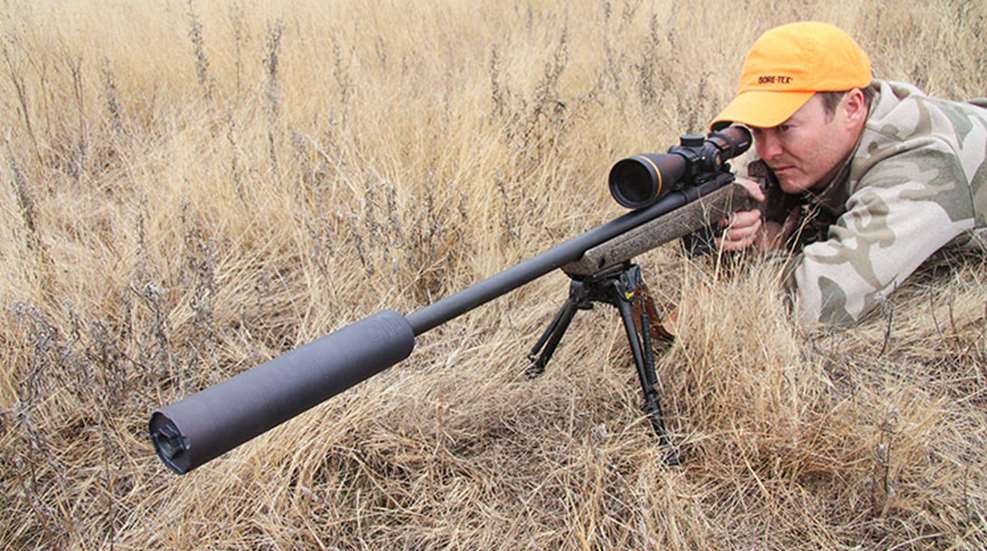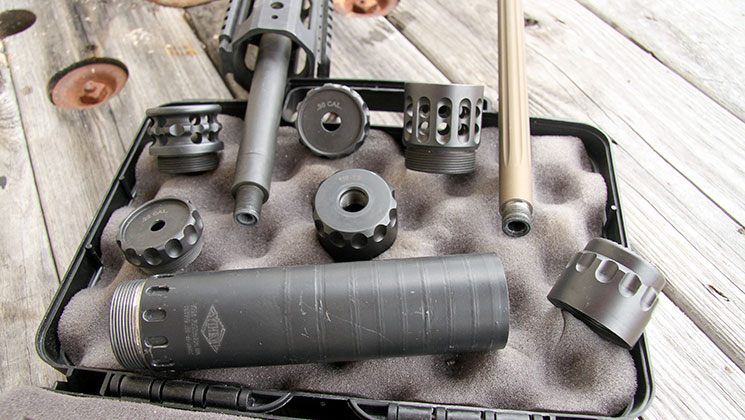
Down at J.D.’s Cafe I overheard a friend of my father complaining about wild hogs ravaging his peanut fields. Trouble was, his farm was now partially bordered by a housing development, and he didn’t want to give his new neighbors any reason to hate him. While his farm was outside city limits, he allowed bowhunting only. That killed off a few pigs, but it didn’t dent the population. So he hired a trapper. That worked for a while, he said, until the hogs grew wise.
At that point in the conversation I leaned over and asked, “What if I hunt ’em at night, with a suppressed rifle?”
Behind crow’s-feet his eyes showed a glimmer of hope as he looked up from his coffee. “That legal?” he asked. “Yep,” I said. We killed 28 pigs over the next three weeks, and no neighbor said a word.
The use of suppressors for hunting is legal in 40 states, but it should be legal everywhere. That’s because suppressors make firearms safer for human ears, make firearms more enjoyable to shoot and reduce hunter/neighbor conflicts arising from noise. These are a few of the reasons why NRA-supported legislation currently in Congress, called the Hearing Protection Act, seeks to trash the $200 tax stamp and the lengthy Bureau of Alcohol, Tobacco, Firearms and Explosives (ATF) approval process required to buy a suppressor.
Today more American hunters are realizing the vast benefits of sound suppression. Despite the excessive $200 tax, demand for suppressors is at an all-time high. And just like my father’s friend, hunters understandably have many questions about hunting suppressed. Here are the answers to some of the most common questions.
Why the Tax?
Firearm silencers, more appropriately called suppressors and dubbed “cans” by soldiers, were invented by Hiram Percy Maxim in 1903 alongside another of his inventions, the automobile muffler. In 1934, however, the near-twin products diverged when the federal government, while battling gangsters such as Al Capone, heavily restricted silencers with passage of the first National Firearms Act. Hoping to gain an advantage on criminals that often had better weapons than cops, the Feds placed a mandatory “sin” tax on silencers that was so high it would effectively ban their purchase by all but the wealthiest individuals. In 1934, $200 was the equivalent of $3,500 today.
The $200 tax still stands despite no evidence that a simple metal tube is capable of causing crime. In fact, research from Finland, where silencers can be purchased over-the-counter, suggests the opposite.
In some cases suppressors negate the need to wear hearing protection, thereby increasing the shooter’s situational awareness and ability to hear game. Suppressors also reduce recoil and make the shooting experience more enjoyable. Plus, the use of suppressors disturbs less game and makes for happier neighbors. They’re also just plain fun.
How Quiet Are They?
Suppressors retard the speed of propellant gases from the cartridge that rapidly expand and rush out of the barrel. It’s these gases that produce the loud boom that’s heard for miles. A suppressor’s series of internal baffles slows these gases so they are not all released at once, thereby muffling the sound. What remains is a report that measures 10-60 decibels lower than a firearm’s normal sound level.
For reference, 30 decibels is the equivalent of a whisper; 90 is a squeeze toy; 125 is a balloon popping; and 160 is a shotgun or rifle firing. Most suppressors lower a gun’s report below 135 decibels. Anything below 135 decibels is considered safe by the Occupational Safety and Health Administration for brief periods of exposure.
Regardless of a suppressor’s effectiveness at the muzzle, the supersonic crack of a rifle bullet as it breaks the sound barrier cannot be mitigated by one. While this whip-like sound is generally not dangerous to the ears because it occurs downrange, it’s loud. It can only be eliminated by firing subsonic rounds, or those traveling slower than approximately 1100 fps at sea level. In general, however, subsonic rounds aren’t desirable for hunting big game due to their lack of energy. (For example, a 55-grain bullet from a .223 Rem. fired at 1090 fps has a muzzle energy of only 145 ft.-lbs., compared to that of a typical 40-grain bullet from a .22 LR with about 140 ft.-lbs. of muzzle energy.) While not “silent” as Hollywood portrays guns fired with suppressors, any reduction in noise is a good thing for the hunting community.
Will They Affect Accuracy?
Attaching any object to the end of a rifle barrel can alter its harmonics and therefore its accuracy in terms of group size and point of impact. With suppressors, sometimes nothing changes. Sometimes accuracy worsens. Many times, however, group size actually improves with a suppressor due to more favorable harmonics and better shooting promoted by lower recoil. Any point-of-impact shift can easily be corrected by re-zeroing the riflescope or sights.
How Do They Attach?
The most common method of suppressor attachment is called direct thread. This requires the muzzle of your firearm’s barrel to be threaded (many of the newer rifle models have this feature). The suppressor screws onto it like a nut screws onto a bolt. There are many thread types, but the most common are 1/2x28 for most .22 calibers, 9mm handguns and AR-15s, and 5/8x24 for rifles of .308 and similar size. If your gun’s muzzle isn’t threaded, take it to a competent gunsmith or buy a replacement barrel for it. The direct thread’s advantage is it’s generally the most stable attachment method, which aids accuracy. It’s also the most affordable. The disadvantage is that it takes 10-20 seconds to install a suppressor on the threads. The second attachment style is quick attachment (QA). A brand-specific QA adaptor must be threaded to your firearm’s barrel; a corresponding female adaptor is threaded to the suppressor. Then the suppressor can be affixed to the firearm with a partial twist that takes less than a second.
An integral suppressor means the barrel and suppressor are one permanent unit. It usually consists of an inner, ported barrel and an outer sleeve. The integral’s advantage is that the barrel’s overall length is not increased, so the gun looks more conventional and balances more naturally. The downside is the suppressor cannot be swapped to other guns. Integrally suppressed barrels and firearms can be expensive due to the cost of the barrel/firearm, the suppressor and the tax stamp.
What Type Should I Buy?
For most hunting applications, direct thread is the best choice. If you intend to buy only one suppressor yet you have multiple guns, it’s advantageous to buy a model sized and rated for the largest caliber you intend to use. While a suppressor made specifically for a .223 Rem. will reduce the sound of that round slightly better than a model made for .30 caliber, for example, you can use a .30-caliber can for smaller calibers—but not vice-versa.
In general, the bigger the can, the more it reduces sound. Smaller suppressors, however, are easier to carry in the woods. Some are more versatile, while others are designed especially for semi-auto handguns or are rated for the heaviest magnums.
How Do I Get One?
Find a Class 3 dealer, one authorized by the ATF to sell suppressors, and pick out a model. Download and fill out ATF Form 4 then get fingerprinted. Along with two completed copies of Form 4, submit your fingerprint card, passport photo and a check for $200 to the ATF. Then wait an average of nine months for your application to be approved, at which time you can pick up the suppressor from your dealer.
Or, go to silencershop.com and pick out one. From there simply authorize your $200 payment and visit one of the company’s automated kiosks to enter your info, signature and fingerprints. Finally, take a selfie and upload it via the Silencer Shop Mobile app. The folks at Silencer Shop will do the rest of the work and send you the suppressor when your application is approved. The site also has terrific prices.
Choice Cans

Ruger Silent-SR ISB
The Ruger Silent-SR ISB is an integrally suppressed replacement barrel for the company’s venerable 10/22 Takedown. It’s perhaps the ultimate backyard squirrel snuffer. MSRP: $629; ruger.com.

Yankee Hill Machine Nitro 30 Stainless
Yankee Hill Machine’s Nitro 30 Stainless is one of the most versatile suppressors. It comes in a kit that has two thread-attachment adaptors and end caps so it can fit pistols, rimfires or rifles up to .30 caliber. Despite the modularity it remains about average in terms of size vs. sound reduction. MSRP: $890; yhm.net.

Q Full Nelson
The Q Full Nelson is huge at 1.75 inches wide and nearly 9 inches long, but it’s relatively light because it’s made of titanium. The Full Nelson reduces the report of even the loudest .30-caliber magnums. MSRP: $899; liveqordie.com.




































